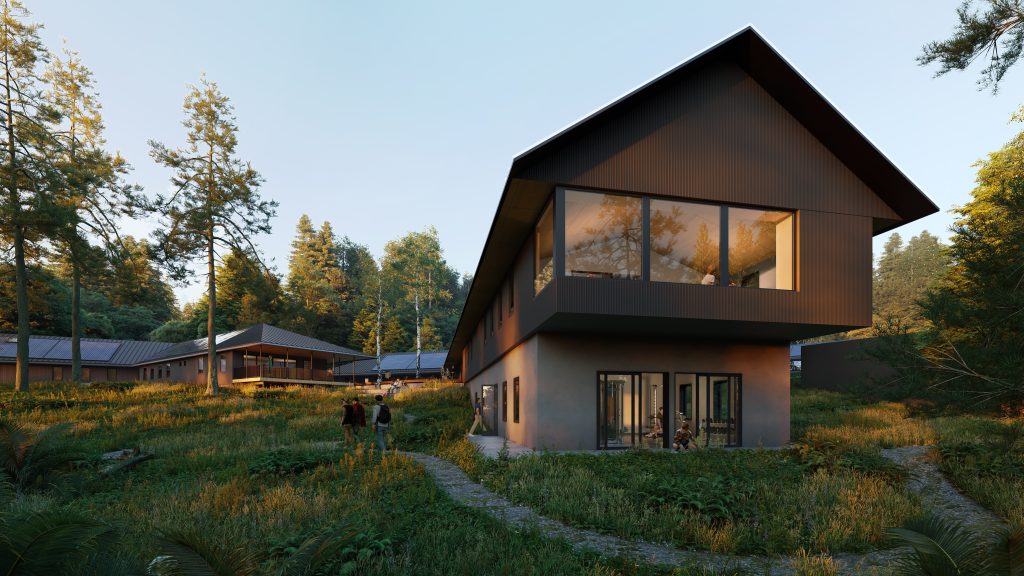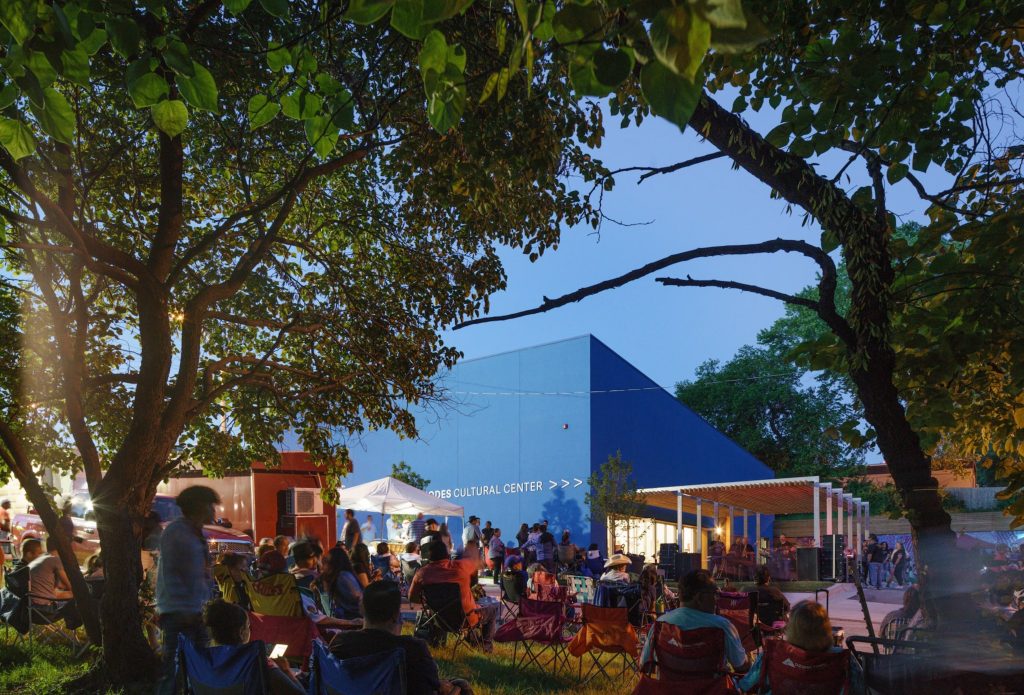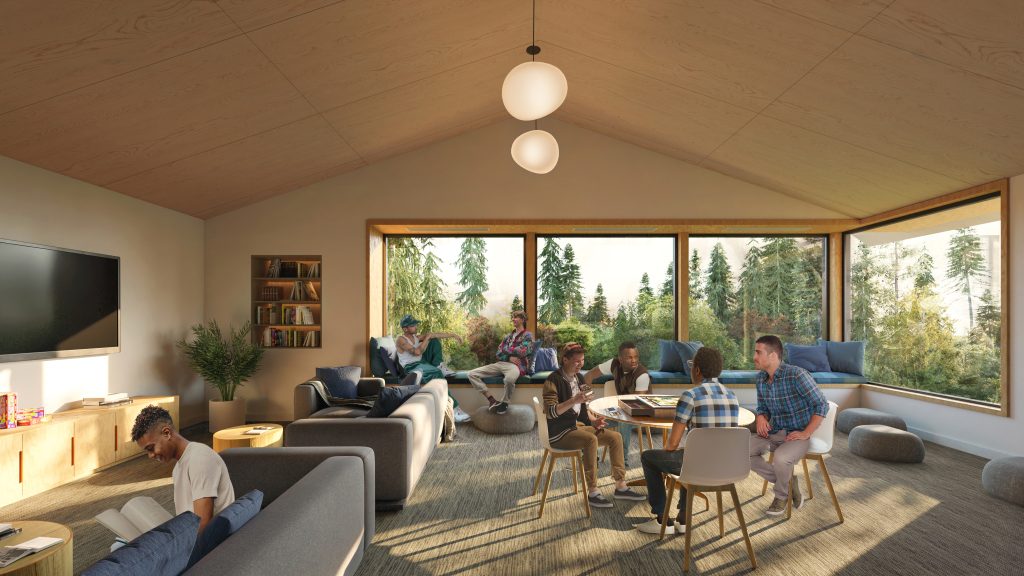As design professionals increasingly strive to create environments for health and well-being, an emerging discipline aimed at supporting recovery from trauma is drawing increased attention. Referred to broadly as trauma informed design (TID), this novel framework for creating spaces that foster recovery and healing, indoors and out, focuses on incorporating architectural and landscape elements with positive psychological and behavioral impacts. Through their design, these environments reduce or eliminate potentially harmful elements as well as anticipated triggers that could cause individuals aiming for recovery to backslide.

Based in principles of environmental psychology, TID has become the subject of wide attention and new research, gathering interest and advocates among design professionals and diverse clientele, especially in the behavioral healthcare sector. In its early stage, experts note that more established studies are needed to advance the efficacy of TID and avoid the misperceptions among would-be practitioners. Most existing studies are literature reviews aimed at providing a basis for employing TID principles in non-healthcare settings such as schools¹ or supportive housing² for homeless individuals. These represent important steps forward for an emerging field. Unfortunately, one may also find a great deal of available material purporting to set forth recommendations or standards for TID with little or no basis in research. For this reason, lighting designers and architects consulting on behavioral healthcare settings should first consider client input from service providers as well as mental and behavioral healthcare professionals. This will help to design for the intended population and make the spaces and experiences as effective as possible, with care to avoid unintended triggers for traumatized end-users. That said, it is possible to identify useful guideposts for practitioners, even as limited practice guidance exists, and to produce valuable environments for healing.

Coming from a discipline with its roots in building systems and engineering, lighting professionals have focused much of their efforts on quantifiable data surrounding task illumination standards. However, TID projects require something from project team members that may be less familiar: direct engagement with the end-user groups.
Trauma is subjective to the person or population who has endured it, making it important to develop TID solutions that designers can apply to specific situations if not generally across projects—even within a typology such as academic or behavioral healthcare settings. Project teams can devise sets of principles to guide their thinking and help communicate the process to client groups and the larger public, yet the work of design for specific environments must treat each end-user group as distinct from others, with the resulting design being responsive to that unique type of trauma as well as the circumstances and places where it arises. In this way, the best project solutions guard against developing sets of superficial applications with the intent of replicating them in unrelated projects.
The TID proposition requires the design team to rethink the typology even if—or especially if—it is their claimed area of specialty and expertise. To do so requires rigorous engagement with the end users, both those in need of healing and those providing care, to arrive at a thorough understanding of what kinds of environmental factors could impede recovery.
Using surveys and interviews, the project team can build upon a bespoke data set and apply it in the design process as they would any stakeholder input, integrating architectural and illumination strategies that promote healing within the given population. This work should draw on established research and practice in designing environments for healing, considering the following principles, among others:
- reducing known adverse stimuli and environmental stressors
- providing connections to the natural world in a dynamic, multisensory environment incorporating daylighting and support for natural circadian rhythms
- promoting privacy and self-reliance
- reinforcing a sense of personal identity
- supporting choice and end-user control over the environment.
In instances where an accepted convention may come into conflict with a stakeholder-stated goal for supporting recovery, the project team should seek a solution that aligns with that stakeholder rather than reverting to standard practices. Satisfying the safety and comfort of most users must be prioritized over individual preferences.
To arrive at a design that optimally fosters recovery for a specific type of trauma, engagement methods with traumatized individuals that include group discussions, hangouts and/or drawing exercises that are facilitated by trained care providers can be highly revealing and help shape innovative solutions. This type of process engenders trust with the traumatized individuals and their care providers and recognizes the significant effect that spatial design, especially the application of light, can have on psychological comfort.
The lighting design challenge then becomes less about the technical data-driven measurements of illumination and more about how the occupants experience the space as well as their potential to react to certain stimuli. As such, luminance considerations that enhance social connection, privacy, spatial transitions and views offer individuals diverse choices of interior spaces to occupy based upon their personal emotional state. For TID, appropriate illumination is an essential component of crafting the specific environment for healing.
While tailoring the design to the specific population is essential, there are some established principles that a lighting designer should employ. Natural daylight and views to exterior natural landscapes have been shown to positively impact physical and psychological healing, for example. If daylight or views are limited, tunable-white electric lighting systems may be considered to replicate natural solar cycles to maintain circadian entrainment. This regulation has been shown to improve sleep patterns and stabilize occupant moods, which are crucial factors for individuals seeking mental health recovery.
To see what TID looks like on the ground, let’s review a project currently under construction in Oregon City, OR, where El Dorado is leading design efforts for the 80-acre Parrott Creek Child and Family Services campus. The multiphase expansion and renovation is among the first of its kind in the U.S., aiming to support some of the region’s most vulnerable community members: children and families affected by the child-welfare and juvenile-justice systems. In addition to doubling the nonprofit group’s capacity, the goal of the project is to enhance the residential treatment process for traumatized youth by creating modern, supportive buildings in a plan that leverages the landscape as a resource for nature therapy, among other approaches.
El Dorado’s engagement with the young individuals at Parrott Creek included time spent walking through the campus and talking in groups facilitated by trained staff, the other critical user group—to better understand their relationships to their sources of trauma, such as addiction or abuse, and identify sets of potential triggers that should be avoided. Discussions included questions including “What would your ideal dorm or study rooms be like?” Listening to their responses helped the design team to get granular—even influencing seemingly insignificant decisions—such as material choices and design approaches for closets and storage elements.
The process entirely focused on the user groups’ healing, working to understand how they can remain regulated and feel safe. Ultimately, the design embraced natural daylight and outdoor views in shared spaces, especially where windows are elevated, framing views of the tree canopy. Bedrooms emphasize privacy and control while retaining connections to nature. One urgent challenge for the lighting designers was how to deal with possible campus-wide blackouts in extreme winter weather. Darkness is a common trigger among this population, making the individual feel a loss of control, disconnection from surroundings and vulnerable, causing them to revisit their trauma. For these reasons, the design includes failsafe systems that provide illumination in the event of power loss.
TID can be applied at a variety of scales in response to diverse types of trauma, creating unique challenges for the lighting consultant. In Kansas City, MO, the design of the Mattie Rhodes Cultural Center was based on TID principles to serve a population recovering from racial trauma. (Unlike PTSD, racial trauma emerges from continuous direct and indirect exposure to race-based stress, creating a societal trauma with unique effects on individual community members.) Solutions derived from engagement included a sheltered gathering space away from the street and shelving composed of transparent material for establishing visual connections across the interior.
Another example is the Albina Vision Plan, which is aimed at reclaiming a dynamic district of Portland, OR,—after decades of damaging development strategies, freeway construction and waves of urban renewal—for the Black community that has always been there despite resulting displacement from these past actions. At this scale, lighting consultants may eventually engage with community stakeholders alongside urban designers and architects to reimagine whole blocks, finding ways to increase access to daylight where overpasses dominate, illuminating streets and parks for safe access or creating plazas that support evening gatherings. Listening well during engagement helps guide project teams to generate designs that help heal a community that has suffered racialized trauma at a generational level.
References
1 Dak Kopec and J. Davis Harte, “Design as the missing variable in trauma-informed schools,” Supporting and Educating Traumatized Students: A Guide for School-Based Professionals, 2nd Edition, Oxford University Press, 2020.
2 Ceridwen Owen and James Crane, “Trauma-Informed Design of Supported Housing: A Scoping Review through the Lens of Neuroscience,” International Journal of Environmental Research and Public Health, Nov. 2022.


